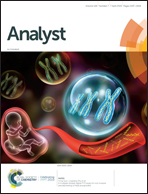Label-free molecular mapping and assessment of glycogen in C. elegans†
Abstract
Caenorhabditis elegans is an animal model frequently used in research on the effects of metabolism on organismal aging. This comes with a requirement for methods to investigate metabolite content, turnover, and distribution. The aim of our study was to assess the use of a label-free approach to determine both content and distribution of glycogen, the storage form of glucose, in C. elegans. To this end, we grew C. elegans worms under three different dietary conditions for 24–48 h, representing starvation, regular diet and a high glucose diet, followed by analysis of glycogen content. Glycogen analysis was performed on fixed individual whole worms using Raman micro-spectroscopy (RMS). Results were confirmed by comparison with two conventional assays, i.e. iodine staining of worms and enzymatic determination of glycogen. RMS was further used to assess overall lipid and protein content and distribution in the same samples used for glycogen analysis. Expectedly, both glycogen and lipid content were highest in worms grown on a high glucose diet, lower in regularly fed, and lowest in starved nematodes. In summary, RMS is a method suitable for analysis of glycogen content in C. elegans that has the advantage over established methods that (i) individual worms (rather than hundreds per sample) can be analyzed, (ii) glycogen distribution can be assessed at subcellular resolution and (iii) the distribution patterns of other macromolecules can be assessed from the same worms. Thus, RMS has the potential to be used as a sensitive, accurate, cost-effective and high throughput method to evaluate glycogen stores in C. elegans.



 Please wait while we load your content...
Please wait while we load your content...